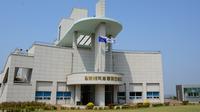Northern Limit Line and Ganghwa History Day Trip from Seoul
Seoul, South Korea
Trip Type: Day Trips
Duration: 9 hours
On this day trip from Seoul, head to South Korea's Northern Limit Line (NLL) and learn about Ganghwa history. The NLL is the maritime demarcation line in the West Sea between South Korea and North Korea. On this tour, stop off at the Ganghwa Peace Observatory, the closest place to North Korea from where you can see North Korea and the lifestyle of North Koreans. Learn about and understand Korea’s divided history on this tour. In addition, go to the Ganghwa History Museum, Dolmen Site (a UNESCO World Heritage Historic Site), and Jeondeungsa Temple.
More About This Activity All Day Trips →
On this day trip from Seoul, head to South Korea's Northern Limit Line (NLL) and learn about Ganghwa history. The NLL is the maritime demarcation line in the West Sea between South Korea and North Korea. On this tour, stop off at the Ganghwa Peace Observatory, the closest place to North Korea from where you can see North Korea and the lifestyle of North Koreans. Learn about and understand Korea’s divided history on this tour. In addition, go to the Ganghwa History Museum, Dolmen Site (a UNESCO World Heritage Historic Site), and Jeondeungsa Temple.Meet your friendly tour guide at the City Hall Subway Station, exit number 6 (subway lines number 1 and 2) at 8:50am. Your tour bus will then leave at 9am.
Your first tour destination is Ganghwa Peace Observatory. It was constructed in the northern area of the Civilian Control Line (CCL) in 2008. It is the nearest place to North Korea where you can see North Korea and lifestyle of local North Koreans since it’s only 1.8km away from North Korea. At the observatory, use the telescope to see North Korea and the lifestyle of North Koreans. Since the tour guide explains about North Korea and Korean War history, you will learn and understand more about Korea. In addition, since it is a controlled zone for civilians, this area has not been developed much so the foreshore and forest groves are very well preserved.
Continue to the Ganghwa History Museum and the Dolmen Site.
The Ganghwa History Museum was opened in 2010 and is located inside Ganghwa Dolmen Park, which was designated as a UNESCO World Heritage Historic Site (No.137). Here you can learn about the history and culture of Ganghwa from the prehistoric ages to the modern times based on artifacts from the area.
After the Ganghwa History Museum, you will walk to the Dolmen Site with your tour guide. Here you can see a very big dolmen which is a table-type dolmen 2.6 meters high.
Then, head to Kanggae Merchants which is a red ginseng manufacturing plant. Ginseng is an important cultural item in Korea. Ganghwa Island in particular is renowned for its ginseng products. Here you can learn about Korean ginseng and see how ginseng products are made. In addition, you can buy ginseng product if you would like.
Lastly, you will visit Jeondeungsa Temple. This temple contains significant architectural works, including the main building Daeungbojeon. You can see names of soldiers written on the walls and columns of Daeungbojeon. These soldiers fought against the French Navy and wrote their names in Jeondeungsa to pray to Buddha for good luck in war. You can also see ten other structures of historical significance at the temple including Yaksajeon (Treasure No. 179), Beomjong Bell (Treasure No. 393, constructed in the 11th century), and Yangheonsu Victory Monument (Tangible Cultural Treasure No. 26).
Finally, the tour will end back at Seoul City Hall which is close to many other tourist attractions.
Your first tour destination is Ganghwa Peace Observatory. It was constructed in the northern area of the Civilian Control Line (CCL) in 2008. It is the nearest place to North Korea where you can see North Korea and lifestyle of local North Koreans since it’s only 1.8km away from North Korea. At the observatory, use the telescope to see North Korea and the lifestyle of North Koreans. Since the tour guide explains about North Korea and Korean War history, you will learn and understand more about Korea. In addition, since it is a controlled zone for civilians, this area has not been developed much so the foreshore and forest groves are very well preserved.
Continue to the Ganghwa History Museum and the Dolmen Site.
The Ganghwa History Museum was opened in 2010 and is located inside Ganghwa Dolmen Park, which was designated as a UNESCO World Heritage Historic Site (No.137). Here you can learn about the history and culture of Ganghwa from the prehistoric ages to the modern times based on artifacts from the area.
After the Ganghwa History Museum, you will walk to the Dolmen Site with your tour guide. Here you can see a very big dolmen which is a table-type dolmen 2.6 meters high.
Then, head to Kanggae Merchants which is a red ginseng manufacturing plant. Ginseng is an important cultural item in Korea. Ganghwa Island in particular is renowned for its ginseng products. Here you can learn about Korean ginseng and see how ginseng products are made. In addition, you can buy ginseng product if you would like.
Lastly, you will visit Jeondeungsa Temple. This temple contains significant architectural works, including the main building Daeungbojeon. You can see names of soldiers written on the walls and columns of Daeungbojeon. These soldiers fought against the French Navy and wrote their names in Jeondeungsa to pray to Buddha for good luck in war. You can also see ten other structures of historical significance at the temple including Yaksajeon (Treasure No. 179), Beomjong Bell (Treasure No. 393, constructed in the 11th century), and Yangheonsu Victory Monument (Tangible Cultural Treasure No. 26).
Finally, the tour will end back at Seoul City Hall which is close to many other tourist attractions.
« Go Back

